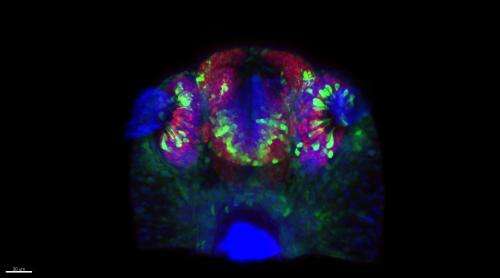Developing our sense of smell: Biologists pinpoint the origin of olfactory nerve cells

When our noses pick up a scent, whether the aroma of a sweet rose or the sweat of a stranger at the gym, two types of sensory neurons are at work in sensing that odor or pheromone. These sensory neurons are particularly interesting because they are the only neurons in our bodies that regenerate throughout adult life—as some of our olfactory neurons die, they are soon replaced by newborns. Just where those neurons come from in the first place has long perplexed developmental biologists.
Previous hypotheses about the origin of these olfactory nerve cells have given credit to embryonic cells that develop into skin or the central nervous system, where ear and eye sensory neurons, respectively, are thought to originate. But biologists at the California Institute of Technology (Caltech) have now found that neural-crest stem cells—multipotent, migratory cells unique to vertebrates that give rise to many structures in the body such as facial bones and smooth muscle—also play a key role in building olfactory sensory neurons in the nose.
"Olfactory neurons have long been thought to be solely derived from a thickened portion of the ectoderm; our results directly refute that concept," says Marianne Bronner, the Albert Billings Ruddock Professor of Biology at Caltech and corresponding author of a paper published in the journal eLIFE on March 19 that outlines the findings.
The two main types of sensory neurons in the olfactory system are ciliated neurons, which detect volatile scents, and microvillous neurons, which usually sense pheromones. Both of these types are found in the tissue lining the inside of the nasal cavity and transmit sensory information to the central nervous system for processing.
In the new study, the researchers showed that during embryonic development, neural-crest stem cells differentiate into the microvillous neurons, which had long been assumed to arise from the same source as the odor-sensing ciliated neurons. Moreover, they demonstrated that different factors are necessary for the development of these two types of neurons. By eliminating a gene called Sox10, they were able to show that formation of microvillous neurons is blocked whereas ciliated neurons are unaffected.
They made this discovery by studying the development of the olfactory system in zebrafish—a useful model organism for developmental biology studies due to the optical clarity of the free-swimming embryo. Understanding the origins of olfactory neurons and the process of neuron formation is important for developing therapeutic applications for conditions like anosmia, or the inability to smell, says Bronner.
"A key question in developmental biology—the extent of neural-crest stem cell contribution to the olfactory system—has been addressed in our paper by multiple lines of experimentation," says Ankur Saxena, a postdoctoral scholar in Bronner's laboratory and lead author of the study. "Olfactory neurons are unique in their renewal capacity across species, so by learning how they form, we may gain insights into how neurons in general can be induced to differentiate or regenerate. That knowledge, in turn, may provide new avenues for pursuing treatment of neurological disorders or injury in humans."
Next, the researchers will examine what other genes, in addition to Sox10, play a role in the process by which neural-crest stem cells differentiate into microvillous neurons. They also plan to look at whether or not neural-crest cells give rise to new microvillous neurons during olfactory regeneration that happens after the embryonic stage of development.
More information: "Sox10-dependent neural crest origin of olfactory microvillous neurons in zebrafish," elife.elifesciences.org/















